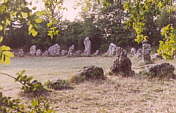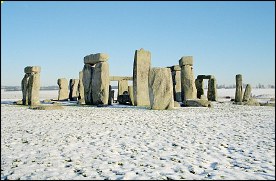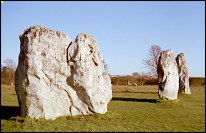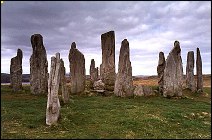I m a g i n e . . .

Walking for miles through the dense forest that covers the land. Mist swirls around, the air is cold and clammy. Yet in the murkiness you sense a presence, that draws you towards it - a faint breath of Spring in the midst of winter.
 Tired,
you stumble on a clearing in the trees, the mist dispels and the pale light of the low
winter sun breaks through. In the clearing before you standing stones nestle against the
trees that surround the clearing, and a soft air of magic suffuses the air. The wind and
the rain of ages past, has carved fantastic patterns on the stones. In the stillness of
the stones, an ermine dances in the rays of the winter sun. This is Megalithia, land of
ancient stones.
Tired,
you stumble on a clearing in the trees, the mist dispels and the pale light of the low
winter sun breaks through. In the clearing before you standing stones nestle against the
trees that surround the clearing, and a soft air of magic suffuses the air. The wind and
the rain of ages past, has carved fantastic patterns on the stones. In the stillness of
the stones, an ermine dances in the rays of the winter sun. This is Megalithia, land of
ancient stones.
It is also the British Isles - with hundreds of megalithic monuments preserved for us. Share with me a while, gentle traveller, a special piece of the history of these Isles.
 Everyone has, of course,
heard of Stonehenge, but far fewer have heard of
magnificent Avebury - big enough to contain a whole
village within the boundaries, and many more treasures to delight and puzzle the traveller
to these great stones linking us to the very dawn of human knowledge. Cornwall is incredibly rich in prehistoric stones, and
Scotland hosts the Standing Stones of Callanish - a
huge and atmospheric stone circle and avenues on the Isle of Lewis. In Wales, and
particularly the Isle of Anglesey, hundreds of stones
have marked the centuries since prehistoric man.
Everyone has, of course,
heard of Stonehenge, but far fewer have heard of
magnificent Avebury - big enough to contain a whole
village within the boundaries, and many more treasures to delight and puzzle the traveller
to these great stones linking us to the very dawn of human knowledge. Cornwall is incredibly rich in prehistoric stones, and
Scotland hosts the Standing Stones of Callanish - a
huge and atmospheric stone circle and avenues on the Isle of Lewis. In Wales, and
particularly the Isle of Anglesey, hundreds of stones
have marked the centuries since prehistoric man.
Ireland has a great megalithic tradition from the beautiful county of Cork peppered with standing stones and circles, and the remarkable Newgrange, a chamber so accurately constructed that only on the midwinter sunrise does a single shaft of light light up the chamber. The passage of the seasons was precious knowledge at these times, and many sites have significant alignments on the Sun or the Moon.
 The legendary alignments of thousands of standing
stones that grace Carnac in
Brittany have no
parallel. They remind us that even in prehistory there were connections between the
British Isles and Europe, which shares with us a rich megalithic
tradition though stone circles are a largely British phenomenon.
The legendary alignments of thousands of standing
stones that grace Carnac in
Brittany have no
parallel. They remind us that even in prehistory there were connections between the
British Isles and Europe, which shares with us a rich megalithic
tradition though stone circles are a largely British phenomenon.
There is a map introduction to the sites and people behind the stones, and a list of sites you can view here.
